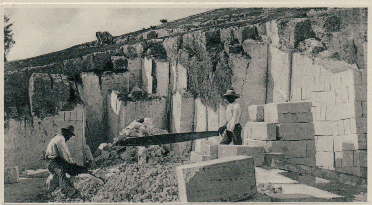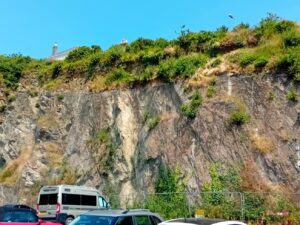Slope Stability Southwest are regularly called out to undertake Quarry Surveys to assess the safety and stability of historic quarries in Cornwall and the Southwest. There are thousands of historic quarries dotted around the landscape of Cornwall and the southwest. Most of these are small, exposed rock faces, tucked away in the hillside and used simply for the extraction of stone for use in local buildings or for the construction of walls and Cornish Hedges, although stone production was also a significant part of the Cornish economy in the 19th Century, and the rich and diverse geology of Cornwall can also be found in some of the most iconic structures in Britain, such as Tower Bridge and Trafalgar Square in London!
These thousands of historic quarries in Cornwall can present various issues and challenges. Many of these quarries have subsequently been developed and it is not unusual to see houses and even small estates of houses tucked into these handy quarry alcoves, often located on a roadside. With the demand for housing high in Cornwall and the southwest, developers and builders are attracted to these historic quarries with their exposed rock faces and their often naturally sheltered outlooks.
However, the safety and stability of an historic quarry must be carefully assessed as part of a Quarry Survey, often as part of the planning process, before the greenlight for development or conveyance can be given.
Some of the problems associated with an historic quarry, that might be identified during a quarry survey include:
Rockfall and slope instability
It is important to remember that rock slopes and quarry faces are not formed naturally but are features that have been cut or excavated from the landscape, often several hundred years previously. Methods of extraction would depend on the type of rock and may vary, from the excavation and cutting of blocks using handheld saws and hammer driven wedges, such as with the limestones around Bath and Bristol.

To the drilling and blasting of the harder granites and porthyritic elvans of Cornwall that were in greatest demand for ornamental building stone. The granite quarries were constructed since the late 1700s and methods of extraction often involved drilling and blasting to remove blocks of stone that could then be shaped by masons for sale and use.
These methods of extraction often lead to problems of rockfall and slope instability. The excavated slope faces are often oversteepened, with natural buttresses having been excavated and removed. Excavation and in particular drilling and blasting can cause damage to the slope face including fracturing, de-lamination (depending on the lithology) and resultant water ingress. This damage can increase the rate of weathering to the slope face and dramatically reduce the stability of the slope face.
Specialist rock slope stability surveys and assessment should be undertaken and remedial works to stabilise the slope face may be required to ensure the long term safety and security of the site.

Potential for land contamination
Quarries can also significantly impact the surrounding environment. Historic quarries were often backfilled, sometimes with overburden or waste rock which is generally inert but may need to be disposed of from the site before development can commence. However quarries were also often used for the uncontrolled disposal of other waste items, including agricultural wastes, commercial and residential putrescible wastes.
This can lead to risks of ground contamination and also associated ground stability risk as a result of ground movement and differential settlement as the waste items move and decompose. Quarries can also create water pollution problems as rainwater can collect in quarries, potentially becoming stagnant and polluted with harmful substances, including chemicals from agricultural run-off or other commercial activities.
A Phase I Land Contamination Desk Study Assessment should be carried out as part of the planning process before any development works are carried out.
If you are a property owner concerned about an historic quarry on your land or looking to purchase a property within or close to a former quarry, Slope Stability Southwest can provide you with expert advice and recommendations about how to address these risk factors. Call us or drop an email over and we would be happy to discuss your concerns with you and provide some free no obligation recommendation and advice.
Take a look at our GeoSLOPE Quarry Survey Report and our website for more details.